Cross-Cultural Training Report: Dubai Managers in Singapore
VerifiedAdded on 2022/11/19
|19
|4006
|131
Report
AI Summary
This report examines the crucial aspects of cross-cultural training for managers relocating from Dubai to Singapore to manage the lifestyle section of Marks and Spencer. It delves into Singapore's unique cultural specificities, including its diverse population and specific laws, and highlights potential challenges arising from cultural differences, such as language barriers and religious sensitivities. The report utilizes established cultural models like Hofstede's, Hall's, GLOBE, and Trompenaars' to analyze these differences and provide a comprehensive understanding of cultural dimensions. Furthermore, it outlines effective cross-cultural training strategies, emphasizing the importance of experienced trainers, appropriate instructional materials, language exploration, business etiquette, and cultural ambassadors to ensure managers' successful integration and performance in their new environment. The report concludes by emphasizing the significance of understanding current affairs and providing adequate employee accommodation to facilitate a smooth transition and promote cross-cultural understanding.
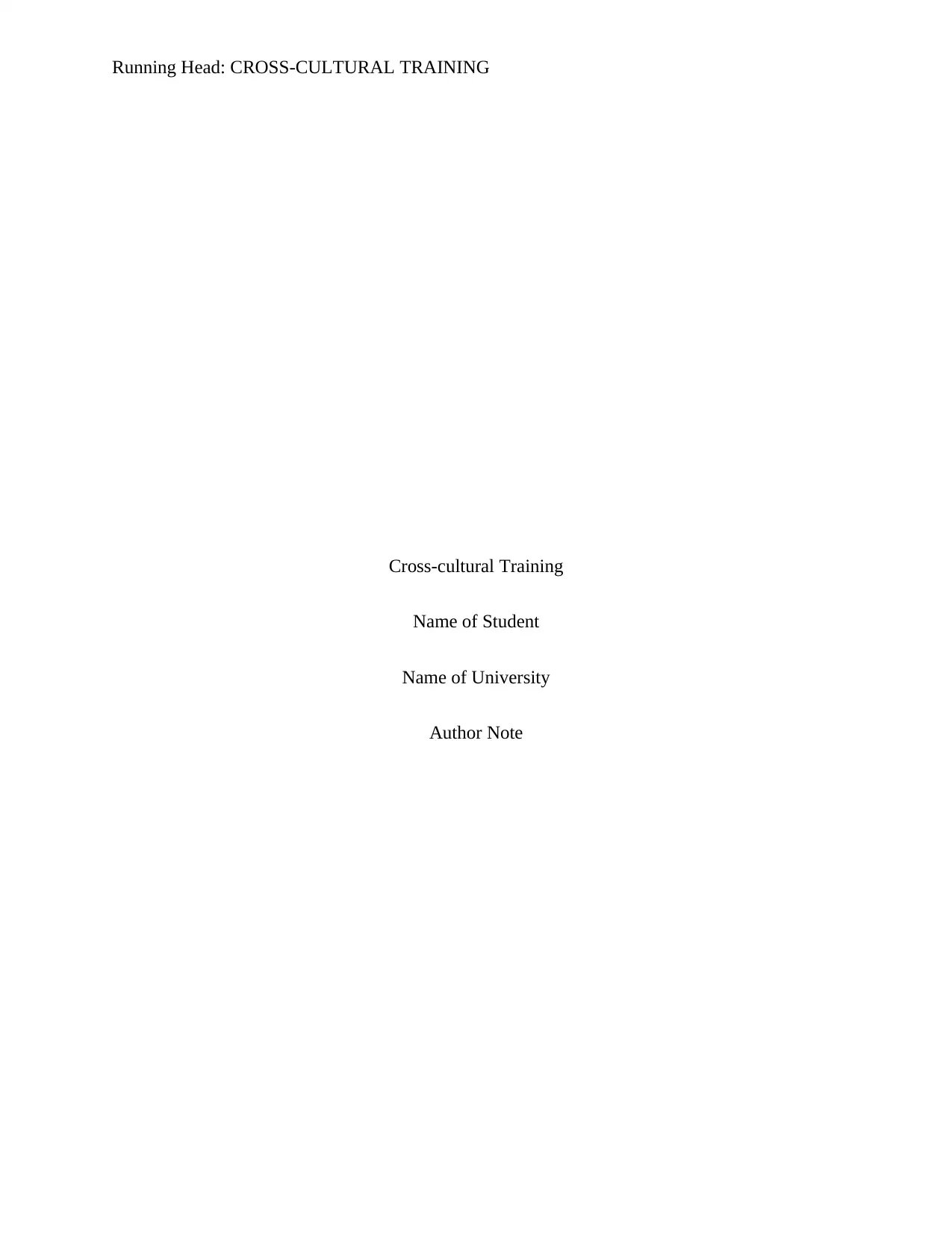
Running Head: CROSS-CULTURAL TRAINING
Cross-cultural Training
Name of Student
Name of University
Author Note
Cross-cultural Training
Name of Student
Name of University
Author Note
Paraphrase This Document
Need a fresh take? Get an instant paraphrase of this document with our AI Paraphraser
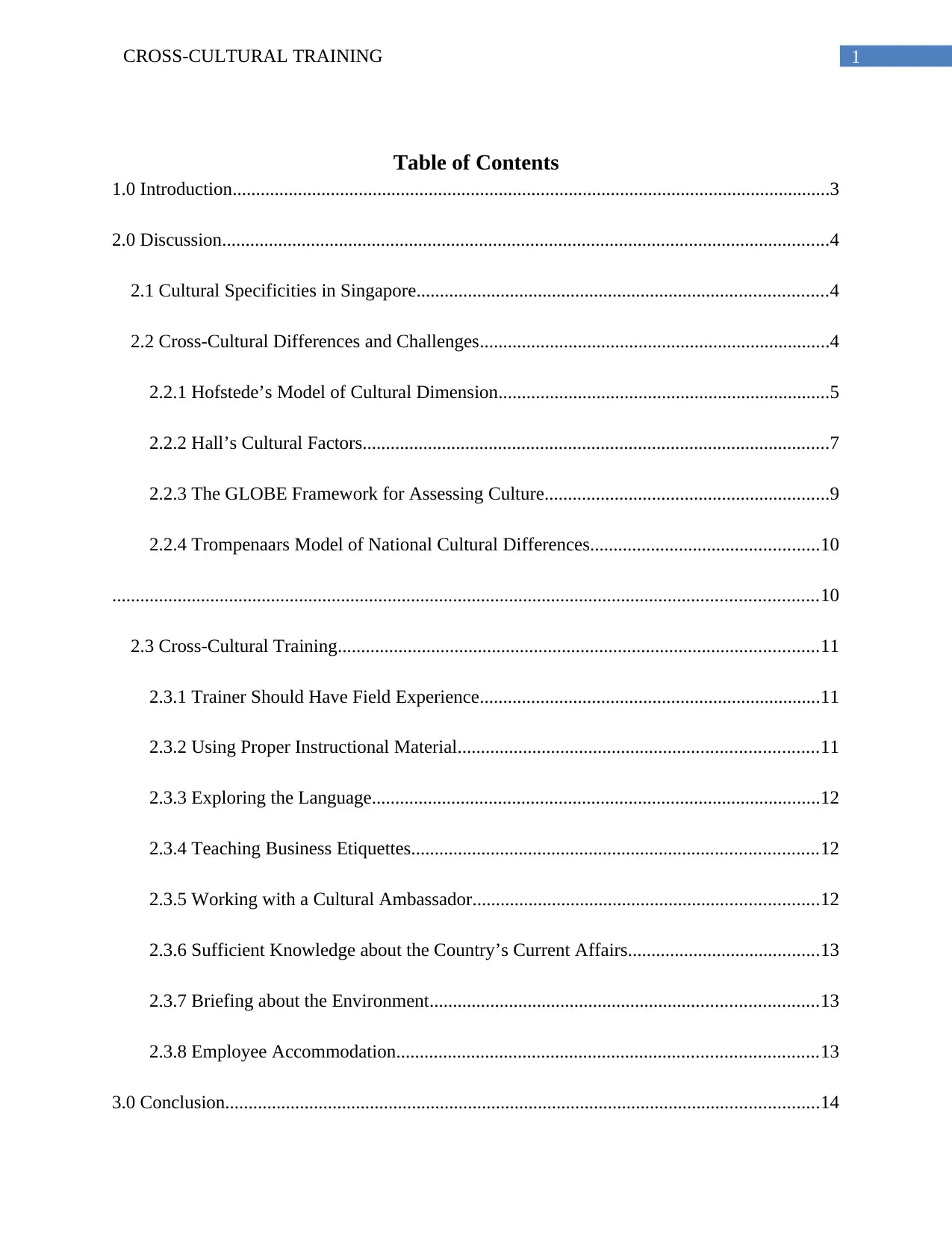
1CROSS-CULTURAL TRAINING
Table of Contents
1.0 Introduction................................................................................................................................3
2.0 Discussion..................................................................................................................................4
2.1 Cultural Specificities in Singapore........................................................................................4
2.2 Cross-Cultural Differences and Challenges...........................................................................4
2.2.1 Hofstede’s Model of Cultural Dimension.......................................................................5
2.2.2 Hall’s Cultural Factors....................................................................................................7
2.2.3 The GLOBE Framework for Assessing Culture.............................................................9
2.2.4 Trompenaars Model of National Cultural Differences.................................................10
.......................................................................................................................................................10
2.3 Cross-Cultural Training.......................................................................................................11
2.3.1 Trainer Should Have Field Experience.........................................................................11
2.3.2 Using Proper Instructional Material.............................................................................11
2.3.3 Exploring the Language................................................................................................12
2.3.4 Teaching Business Etiquettes.......................................................................................12
2.3.5 Working with a Cultural Ambassador..........................................................................12
2.3.6 Sufficient Knowledge about the Country’s Current Affairs.........................................13
2.3.7 Briefing about the Environment...................................................................................13
2.3.8 Employee Accommodation..........................................................................................13
3.0 Conclusion...............................................................................................................................14
Table of Contents
1.0 Introduction................................................................................................................................3
2.0 Discussion..................................................................................................................................4
2.1 Cultural Specificities in Singapore........................................................................................4
2.2 Cross-Cultural Differences and Challenges...........................................................................4
2.2.1 Hofstede’s Model of Cultural Dimension.......................................................................5
2.2.2 Hall’s Cultural Factors....................................................................................................7
2.2.3 The GLOBE Framework for Assessing Culture.............................................................9
2.2.4 Trompenaars Model of National Cultural Differences.................................................10
.......................................................................................................................................................10
2.3 Cross-Cultural Training.......................................................................................................11
2.3.1 Trainer Should Have Field Experience.........................................................................11
2.3.2 Using Proper Instructional Material.............................................................................11
2.3.3 Exploring the Language................................................................................................12
2.3.4 Teaching Business Etiquettes.......................................................................................12
2.3.5 Working with a Cultural Ambassador..........................................................................12
2.3.6 Sufficient Knowledge about the Country’s Current Affairs.........................................13
2.3.7 Briefing about the Environment...................................................................................13
2.3.8 Employee Accommodation..........................................................................................13
3.0 Conclusion...............................................................................................................................14

2CROSS-CULTURAL TRAINING
References......................................................................................................................................15
References......................................................................................................................................15
⊘ This is a preview!⊘
Do you want full access?
Subscribe today to unlock all pages.

Trusted by 1+ million students worldwide
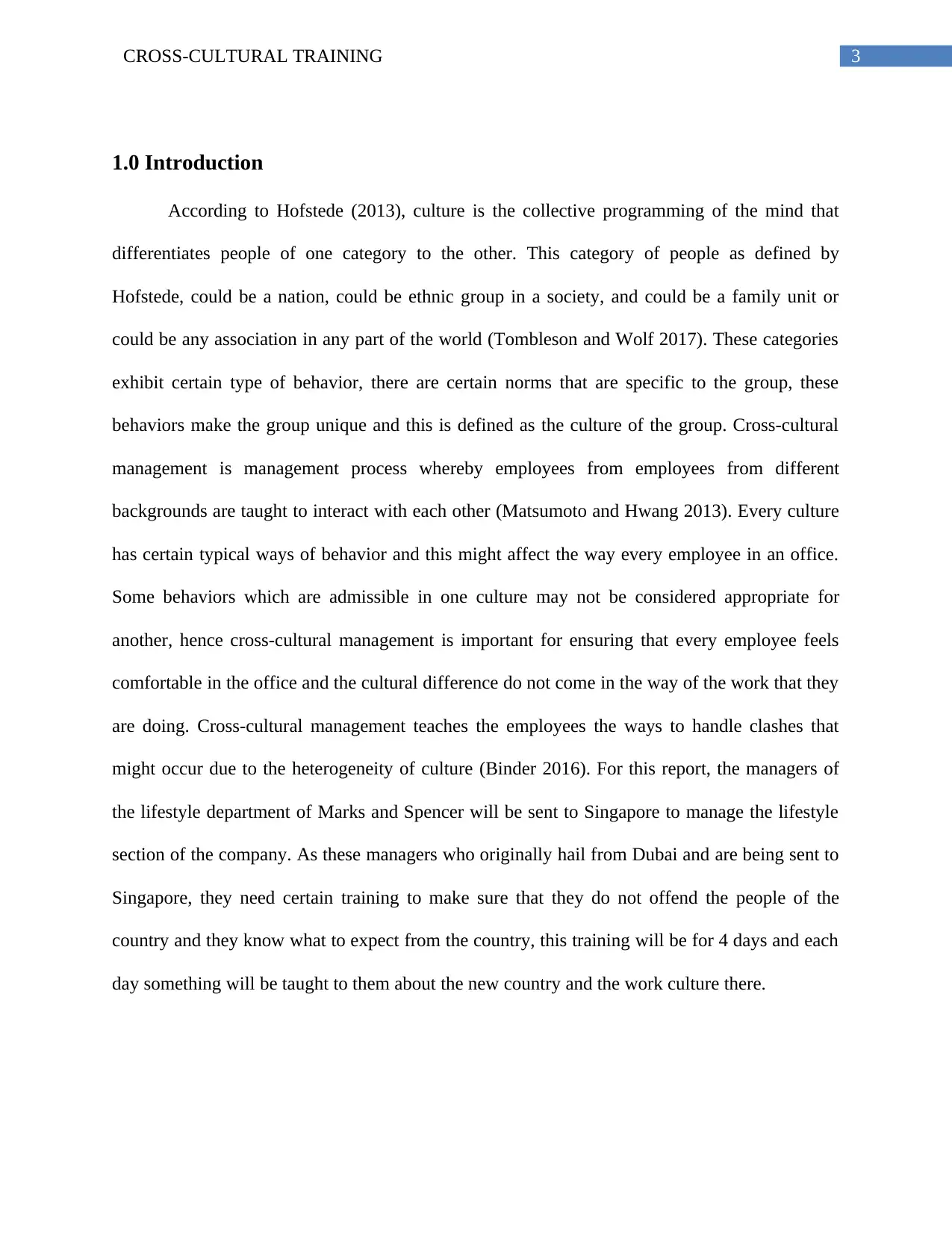
3CROSS-CULTURAL TRAINING
1.0 Introduction
According to Hofstede (2013), culture is the collective programming of the mind that
differentiates people of one category to the other. This category of people as defined by
Hofstede, could be a nation, could be ethnic group in a society, and could be a family unit or
could be any association in any part of the world (Tombleson and Wolf 2017). These categories
exhibit certain type of behavior, there are certain norms that are specific to the group, these
behaviors make the group unique and this is defined as the culture of the group. Cross-cultural
management is management process whereby employees from employees from different
backgrounds are taught to interact with each other (Matsumoto and Hwang 2013). Every culture
has certain typical ways of behavior and this might affect the way every employee in an office.
Some behaviors which are admissible in one culture may not be considered appropriate for
another, hence cross-cultural management is important for ensuring that every employee feels
comfortable in the office and the cultural difference do not come in the way of the work that they
are doing. Cross-cultural management teaches the employees the ways to handle clashes that
might occur due to the heterogeneity of culture (Binder 2016). For this report, the managers of
the lifestyle department of Marks and Spencer will be sent to Singapore to manage the lifestyle
section of the company. As these managers who originally hail from Dubai and are being sent to
Singapore, they need certain training to make sure that they do not offend the people of the
country and they know what to expect from the country, this training will be for 4 days and each
day something will be taught to them about the new country and the work culture there.
1.0 Introduction
According to Hofstede (2013), culture is the collective programming of the mind that
differentiates people of one category to the other. This category of people as defined by
Hofstede, could be a nation, could be ethnic group in a society, and could be a family unit or
could be any association in any part of the world (Tombleson and Wolf 2017). These categories
exhibit certain type of behavior, there are certain norms that are specific to the group, these
behaviors make the group unique and this is defined as the culture of the group. Cross-cultural
management is management process whereby employees from employees from different
backgrounds are taught to interact with each other (Matsumoto and Hwang 2013). Every culture
has certain typical ways of behavior and this might affect the way every employee in an office.
Some behaviors which are admissible in one culture may not be considered appropriate for
another, hence cross-cultural management is important for ensuring that every employee feels
comfortable in the office and the cultural difference do not come in the way of the work that they
are doing. Cross-cultural management teaches the employees the ways to handle clashes that
might occur due to the heterogeneity of culture (Binder 2016). For this report, the managers of
the lifestyle department of Marks and Spencer will be sent to Singapore to manage the lifestyle
section of the company. As these managers who originally hail from Dubai and are being sent to
Singapore, they need certain training to make sure that they do not offend the people of the
country and they know what to expect from the country, this training will be for 4 days and each
day something will be taught to them about the new country and the work culture there.
Paraphrase This Document
Need a fresh take? Get an instant paraphrase of this document with our AI Paraphraser
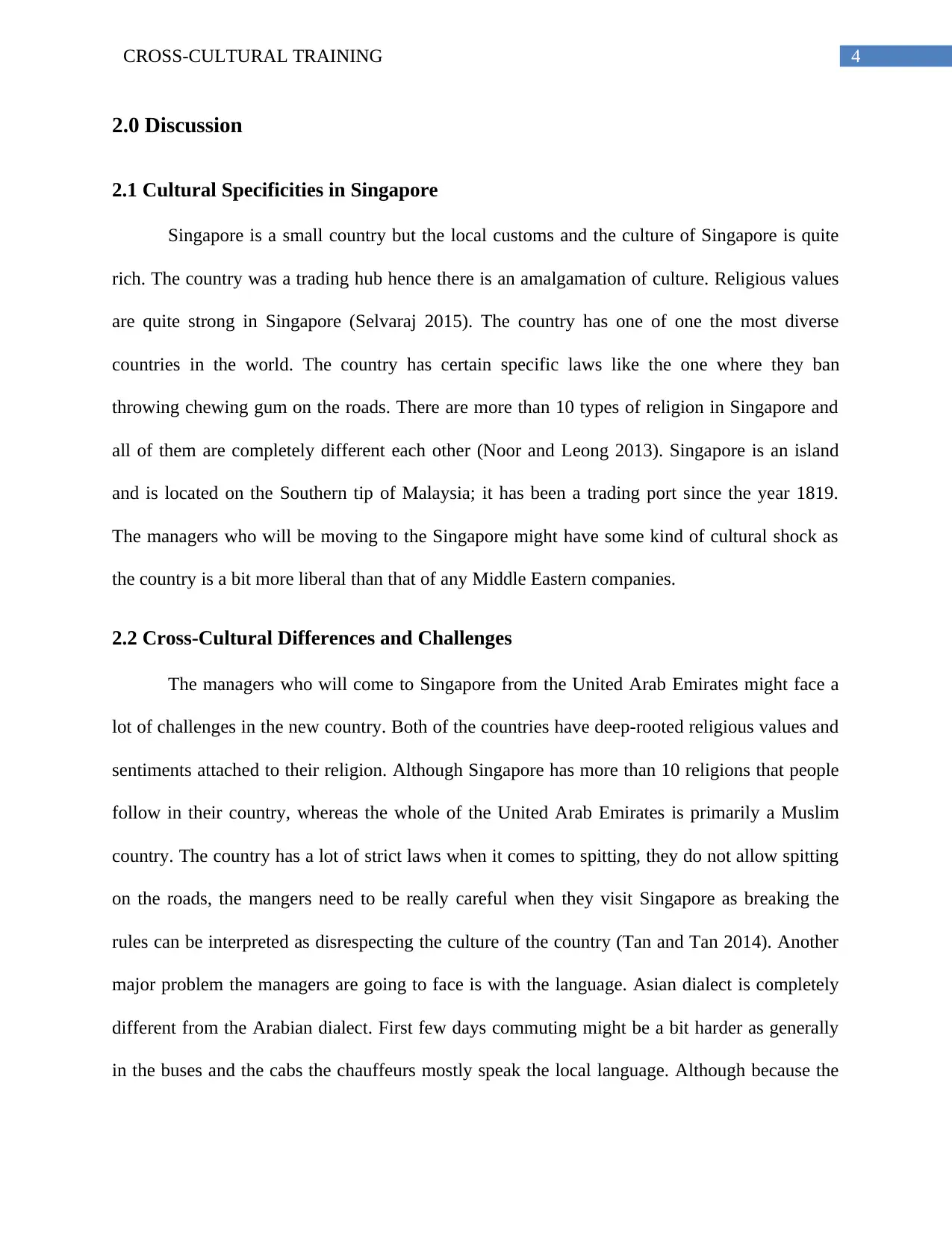
4CROSS-CULTURAL TRAINING
2.0 Discussion
2.1 Cultural Specificities in Singapore
Singapore is a small country but the local customs and the culture of Singapore is quite
rich. The country was a trading hub hence there is an amalgamation of culture. Religious values
are quite strong in Singapore (Selvaraj 2015). The country has one of one the most diverse
countries in the world. The country has certain specific laws like the one where they ban
throwing chewing gum on the roads. There are more than 10 types of religion in Singapore and
all of them are completely different each other (Noor and Leong 2013). Singapore is an island
and is located on the Southern tip of Malaysia; it has been a trading port since the year 1819.
The managers who will be moving to the Singapore might have some kind of cultural shock as
the country is a bit more liberal than that of any Middle Eastern companies.
2.2 Cross-Cultural Differences and Challenges
The managers who will come to Singapore from the United Arab Emirates might face a
lot of challenges in the new country. Both of the countries have deep-rooted religious values and
sentiments attached to their religion. Although Singapore has more than 10 religions that people
follow in their country, whereas the whole of the United Arab Emirates is primarily a Muslim
country. The country has a lot of strict laws when it comes to spitting, they do not allow spitting
on the roads, the mangers need to be really careful when they visit Singapore as breaking the
rules can be interpreted as disrespecting the culture of the country (Tan and Tan 2014). Another
major problem the managers are going to face is with the language. Asian dialect is completely
different from the Arabian dialect. First few days commuting might be a bit harder as generally
in the buses and the cabs the chauffeurs mostly speak the local language. Although because the
2.0 Discussion
2.1 Cultural Specificities in Singapore
Singapore is a small country but the local customs and the culture of Singapore is quite
rich. The country was a trading hub hence there is an amalgamation of culture. Religious values
are quite strong in Singapore (Selvaraj 2015). The country has one of one the most diverse
countries in the world. The country has certain specific laws like the one where they ban
throwing chewing gum on the roads. There are more than 10 types of religion in Singapore and
all of them are completely different each other (Noor and Leong 2013). Singapore is an island
and is located on the Southern tip of Malaysia; it has been a trading port since the year 1819.
The managers who will be moving to the Singapore might have some kind of cultural shock as
the country is a bit more liberal than that of any Middle Eastern companies.
2.2 Cross-Cultural Differences and Challenges
The managers who will come to Singapore from the United Arab Emirates might face a
lot of challenges in the new country. Both of the countries have deep-rooted religious values and
sentiments attached to their religion. Although Singapore has more than 10 religions that people
follow in their country, whereas the whole of the United Arab Emirates is primarily a Muslim
country. The country has a lot of strict laws when it comes to spitting, they do not allow spitting
on the roads, the mangers need to be really careful when they visit Singapore as breaking the
rules can be interpreted as disrespecting the culture of the country (Tan and Tan 2014). Another
major problem the managers are going to face is with the language. Asian dialect is completely
different from the Arabian dialect. First few days commuting might be a bit harder as generally
in the buses and the cabs the chauffeurs mostly speak the local language. Although because the
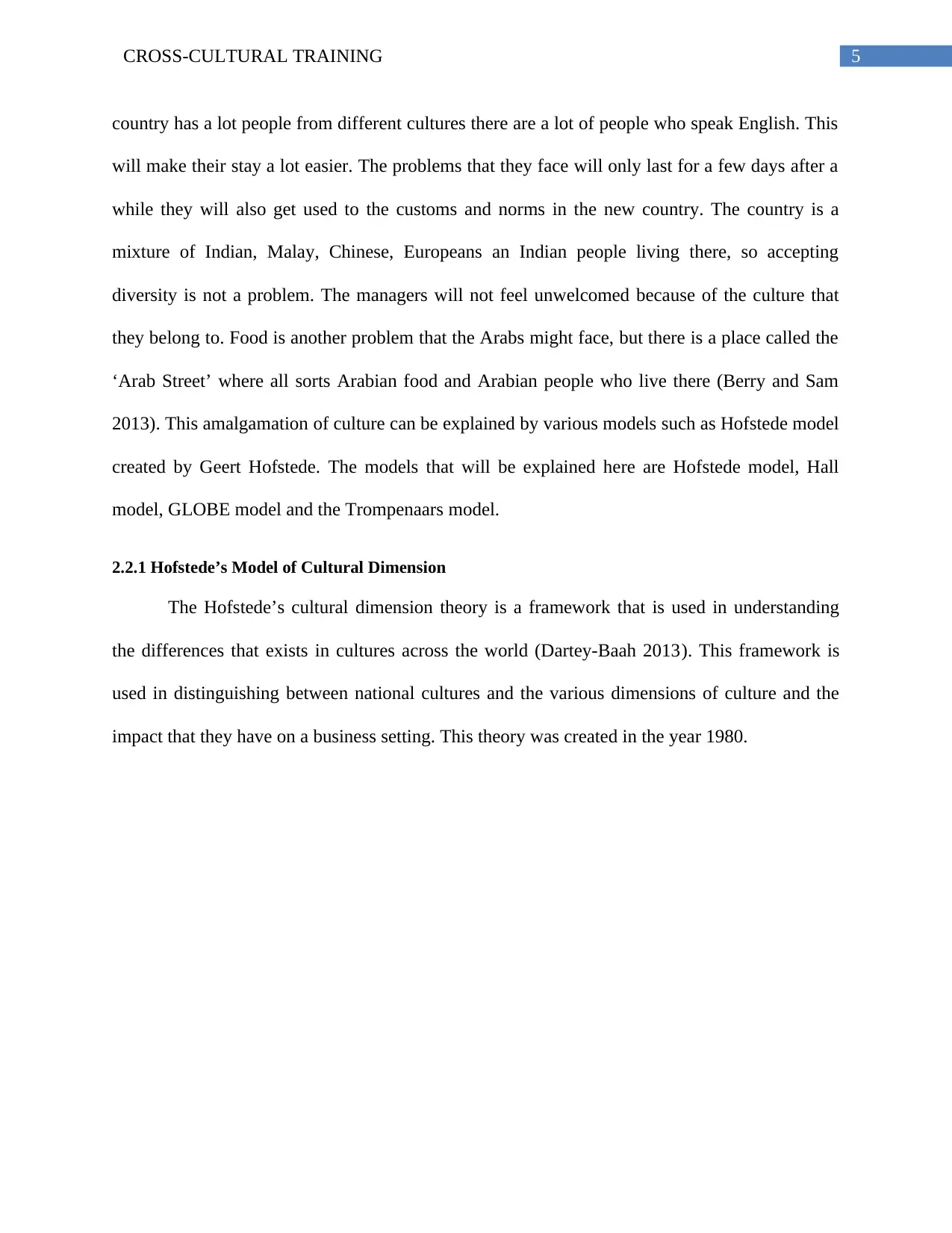
5CROSS-CULTURAL TRAINING
country has a lot people from different cultures there are a lot of people who speak English. This
will make their stay a lot easier. The problems that they face will only last for a few days after a
while they will also get used to the customs and norms in the new country. The country is a
mixture of Indian, Malay, Chinese, Europeans an Indian people living there, so accepting
diversity is not a problem. The managers will not feel unwelcomed because of the culture that
they belong to. Food is another problem that the Arabs might face, but there is a place called the
‘Arab Street’ where all sorts Arabian food and Arabian people who live there (Berry and Sam
2013). This amalgamation of culture can be explained by various models such as Hofstede model
created by Geert Hofstede. The models that will be explained here are Hofstede model, Hall
model, GLOBE model and the Trompenaars model.
2.2.1 Hofstede’s Model of Cultural Dimension
The Hofstede’s cultural dimension theory is a framework that is used in understanding
the differences that exists in cultures across the world (Dartey-Baah 2013). This framework is
used in distinguishing between national cultures and the various dimensions of culture and the
impact that they have on a business setting. This theory was created in the year 1980.
country has a lot people from different cultures there are a lot of people who speak English. This
will make their stay a lot easier. The problems that they face will only last for a few days after a
while they will also get used to the customs and norms in the new country. The country is a
mixture of Indian, Malay, Chinese, Europeans an Indian people living there, so accepting
diversity is not a problem. The managers will not feel unwelcomed because of the culture that
they belong to. Food is another problem that the Arabs might face, but there is a place called the
‘Arab Street’ where all sorts Arabian food and Arabian people who live there (Berry and Sam
2013). This amalgamation of culture can be explained by various models such as Hofstede model
created by Geert Hofstede. The models that will be explained here are Hofstede model, Hall
model, GLOBE model and the Trompenaars model.
2.2.1 Hofstede’s Model of Cultural Dimension
The Hofstede’s cultural dimension theory is a framework that is used in understanding
the differences that exists in cultures across the world (Dartey-Baah 2013). This framework is
used in distinguishing between national cultures and the various dimensions of culture and the
impact that they have on a business setting. This theory was created in the year 1980.
⊘ This is a preview!⊘
Do you want full access?
Subscribe today to unlock all pages.

Trusted by 1+ million students worldwide
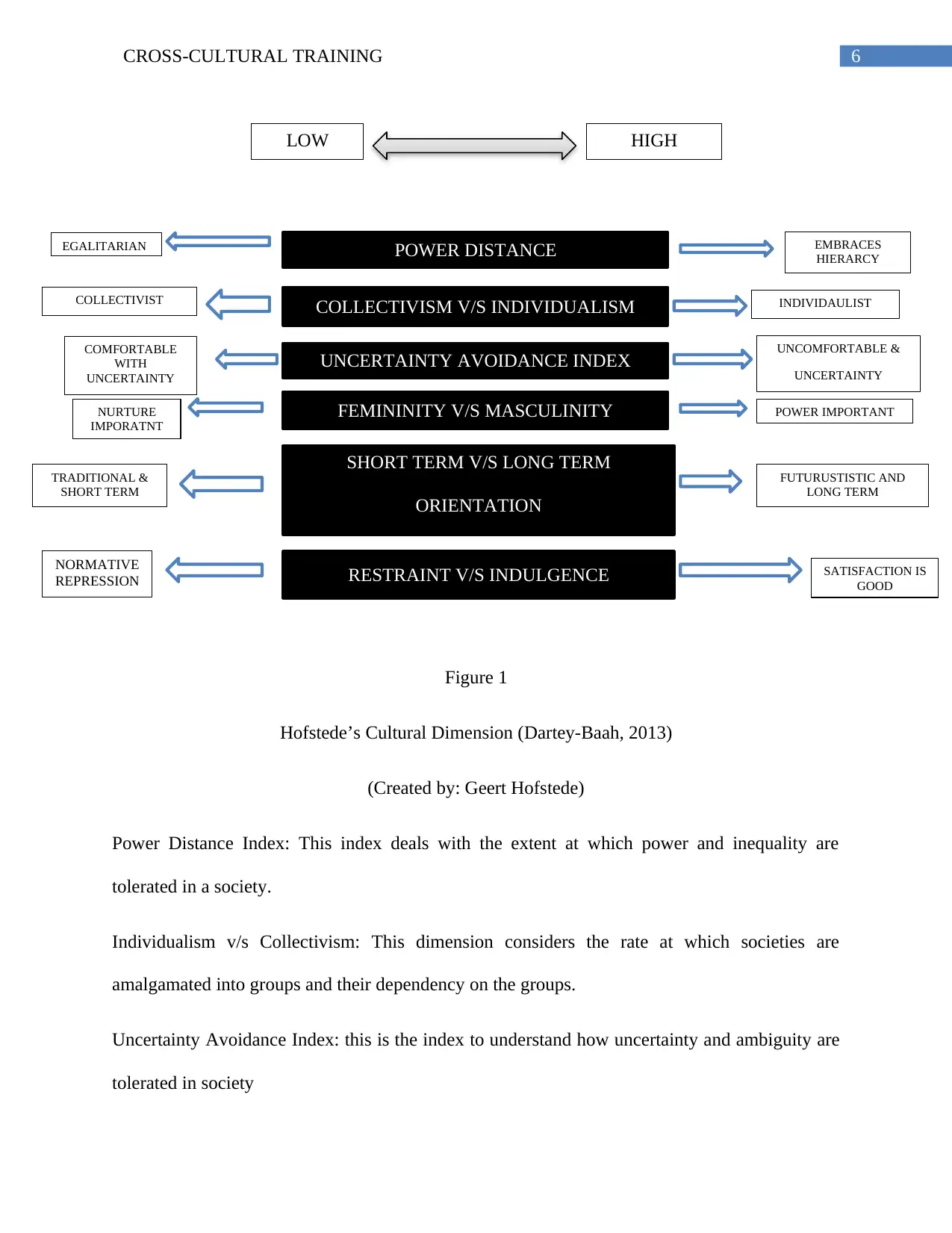
6CROSS-CULTURAL TRAINING
Figure 1
Hofstede’s Cultural Dimension (Dartey-Baah, 2013)
(Created by: Geert Hofstede)
Power Distance Index: This index deals with the extent at which power and inequality are
tolerated in a society.
Individualism v/s Collectivism: This dimension considers the rate at which societies are
amalgamated into groups and their dependency on the groups.
Uncertainty Avoidance Index: this is the index to understand how uncertainty and ambiguity are
tolerated in society
POWER DISTANCE
COLLECTIVISM V/S INDIVIDUALISM
UNCERTAINTY AVOIDANCE INDEX
FEMININITY V/S MASCULINITY
SHORT TERM V/S LONG TERM
ORIENTATION
RESTRAINT V/S INDULGENCE
LOW HIGH
EGALITARIAN EMBRACES
HIERARCY
NORMATIVE
REPRESSION SATISFACTION IS
GOOD
FUTURUSTISTIC AND
LONG TERM
POWER IMPORTANT
UNCOMFORTABLE &
UNCERTAINTY
INDIVIDAULISTCOLLECTIVIST
COMFORTABLE
WITH
UNCERTAINTY
NURTURE
IMPORATNT
TRADITIONAL &
SHORT TERM
Figure 1
Hofstede’s Cultural Dimension (Dartey-Baah, 2013)
(Created by: Geert Hofstede)
Power Distance Index: This index deals with the extent at which power and inequality are
tolerated in a society.
Individualism v/s Collectivism: This dimension considers the rate at which societies are
amalgamated into groups and their dependency on the groups.
Uncertainty Avoidance Index: this is the index to understand how uncertainty and ambiguity are
tolerated in society
POWER DISTANCE
COLLECTIVISM V/S INDIVIDUALISM
UNCERTAINTY AVOIDANCE INDEX
FEMININITY V/S MASCULINITY
SHORT TERM V/S LONG TERM
ORIENTATION
RESTRAINT V/S INDULGENCE
LOW HIGH
EGALITARIAN EMBRACES
HIERARCY
NORMATIVE
REPRESSION SATISFACTION IS
GOOD
FUTURUSTISTIC AND
LONG TERM
POWER IMPORTANT
UNCOMFORTABLE &
UNCERTAINTY
INDIVIDAULISTCOLLECTIVIST
COMFORTABLE
WITH
UNCERTAINTY
NURTURE
IMPORATNT
TRADITIONAL &
SHORT TERM
Paraphrase This Document
Need a fresh take? Get an instant paraphrase of this document with our AI Paraphraser
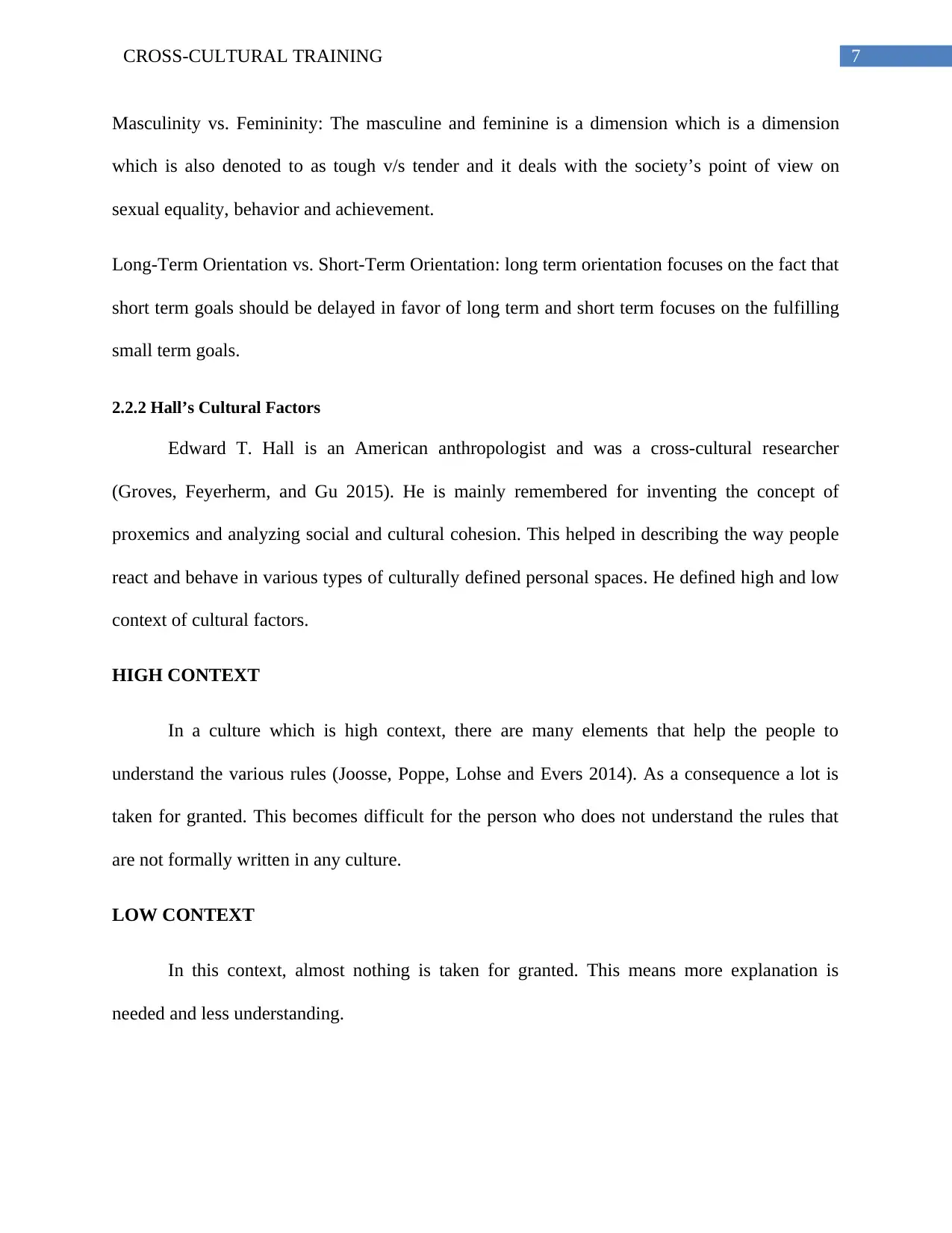
7CROSS-CULTURAL TRAINING
Masculinity vs. Femininity: The masculine and feminine is a dimension which is a dimension
which is also denoted to as tough v/s tender and it deals with the society’s point of view on
sexual equality, behavior and achievement.
Long-Term Orientation vs. Short-Term Orientation: long term orientation focuses on the fact that
short term goals should be delayed in favor of long term and short term focuses on the fulfilling
small term goals.
2.2.2 Hall’s Cultural Factors
Edward T. Hall is an American anthropologist and was a cross-cultural researcher
(Groves, Feyerherm, and Gu 2015). He is mainly remembered for inventing the concept of
proxemics and analyzing social and cultural cohesion. This helped in describing the way people
react and behave in various types of culturally defined personal spaces. He defined high and low
context of cultural factors.
HIGH CONTEXT
In a culture which is high context, there are many elements that help the people to
understand the various rules (Joosse, Poppe, Lohse and Evers 2014). As a consequence a lot is
taken for granted. This becomes difficult for the person who does not understand the rules that
are not formally written in any culture.
LOW CONTEXT
In this context, almost nothing is taken for granted. This means more explanation is
needed and less understanding.
Masculinity vs. Femininity: The masculine and feminine is a dimension which is a dimension
which is also denoted to as tough v/s tender and it deals with the society’s point of view on
sexual equality, behavior and achievement.
Long-Term Orientation vs. Short-Term Orientation: long term orientation focuses on the fact that
short term goals should be delayed in favor of long term and short term focuses on the fulfilling
small term goals.
2.2.2 Hall’s Cultural Factors
Edward T. Hall is an American anthropologist and was a cross-cultural researcher
(Groves, Feyerherm, and Gu 2015). He is mainly remembered for inventing the concept of
proxemics and analyzing social and cultural cohesion. This helped in describing the way people
react and behave in various types of culturally defined personal spaces. He defined high and low
context of cultural factors.
HIGH CONTEXT
In a culture which is high context, there are many elements that help the people to
understand the various rules (Joosse, Poppe, Lohse and Evers 2014). As a consequence a lot is
taken for granted. This becomes difficult for the person who does not understand the rules that
are not formally written in any culture.
LOW CONTEXT
In this context, almost nothing is taken for granted. This means more explanation is
needed and less understanding.
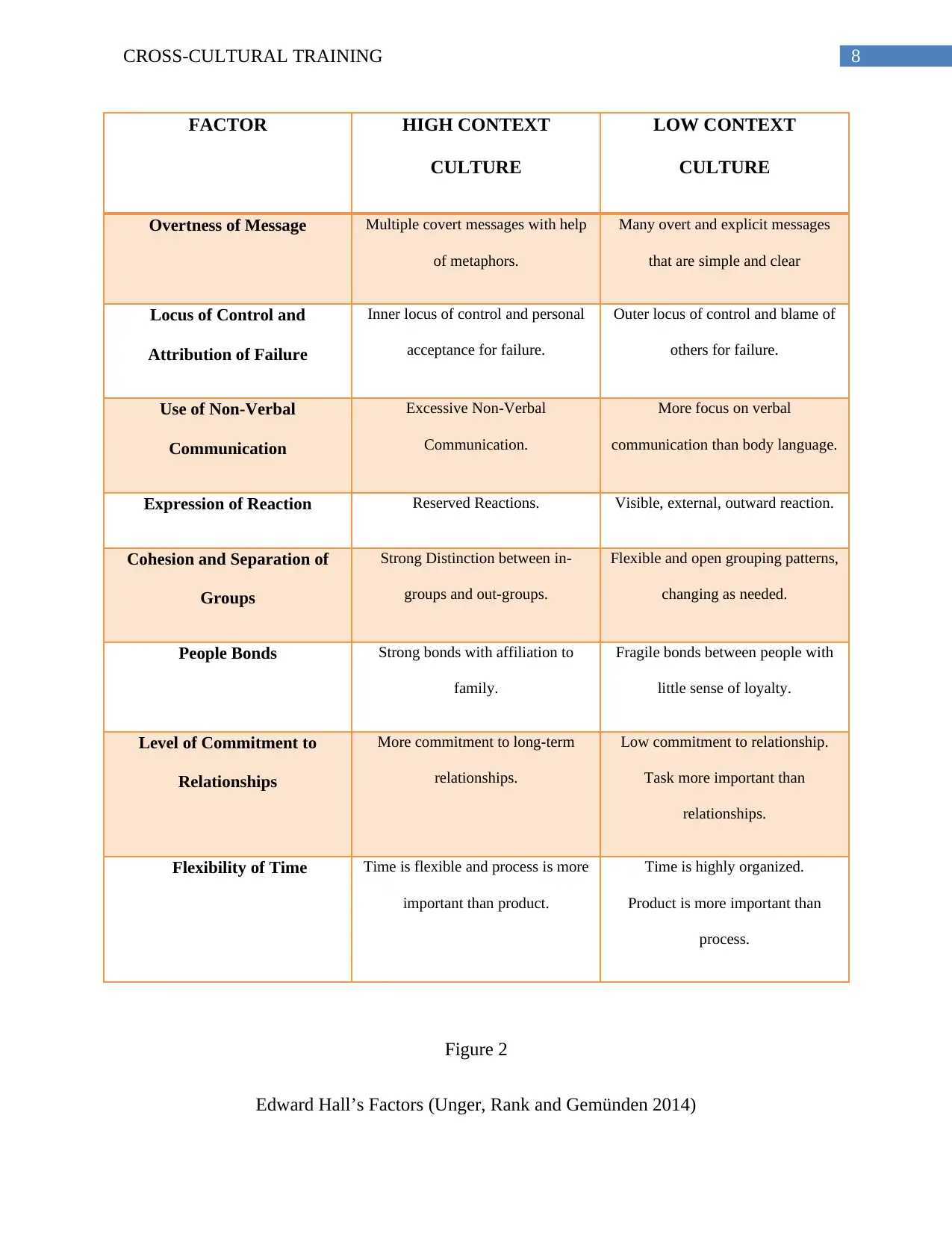
8CROSS-CULTURAL TRAINING
FACTOR HIGH CONTEXT
CULTURE
LOW CONTEXT
CULTURE
Overtness of Message Multiple covert messages with help
of metaphors.
Many overt and explicit messages
that are simple and clear
Locus of Control and
Attribution of Failure
Inner locus of control and personal
acceptance for failure.
Outer locus of control and blame of
others for failure.
Use of Non-Verbal
Communication
Excessive Non-Verbal
Communication.
More focus on verbal
communication than body language.
Expression of Reaction Reserved Reactions. Visible, external, outward reaction.
Cohesion and Separation of
Groups
Strong Distinction between in-
groups and out-groups.
Flexible and open grouping patterns,
changing as needed.
People Bonds Strong bonds with affiliation to
family.
Fragile bonds between people with
little sense of loyalty.
Level of Commitment to
Relationships
More commitment to long-term
relationships.
Low commitment to relationship.
Task more important than
relationships.
Flexibility of Time Time is flexible and process is more
important than product.
Time is highly organized.
Product is more important than
process.
Figure 2
Edward Hall’s Factors (Unger, Rank and Gemünden 2014)
FACTOR HIGH CONTEXT
CULTURE
LOW CONTEXT
CULTURE
Overtness of Message Multiple covert messages with help
of metaphors.
Many overt and explicit messages
that are simple and clear
Locus of Control and
Attribution of Failure
Inner locus of control and personal
acceptance for failure.
Outer locus of control and blame of
others for failure.
Use of Non-Verbal
Communication
Excessive Non-Verbal
Communication.
More focus on verbal
communication than body language.
Expression of Reaction Reserved Reactions. Visible, external, outward reaction.
Cohesion and Separation of
Groups
Strong Distinction between in-
groups and out-groups.
Flexible and open grouping patterns,
changing as needed.
People Bonds Strong bonds with affiliation to
family.
Fragile bonds between people with
little sense of loyalty.
Level of Commitment to
Relationships
More commitment to long-term
relationships.
Low commitment to relationship.
Task more important than
relationships.
Flexibility of Time Time is flexible and process is more
important than product.
Time is highly organized.
Product is more important than
process.
Figure 2
Edward Hall’s Factors (Unger, Rank and Gemünden 2014)
⊘ This is a preview!⊘
Do you want full access?
Subscribe today to unlock all pages.

Trusted by 1+ million students worldwide
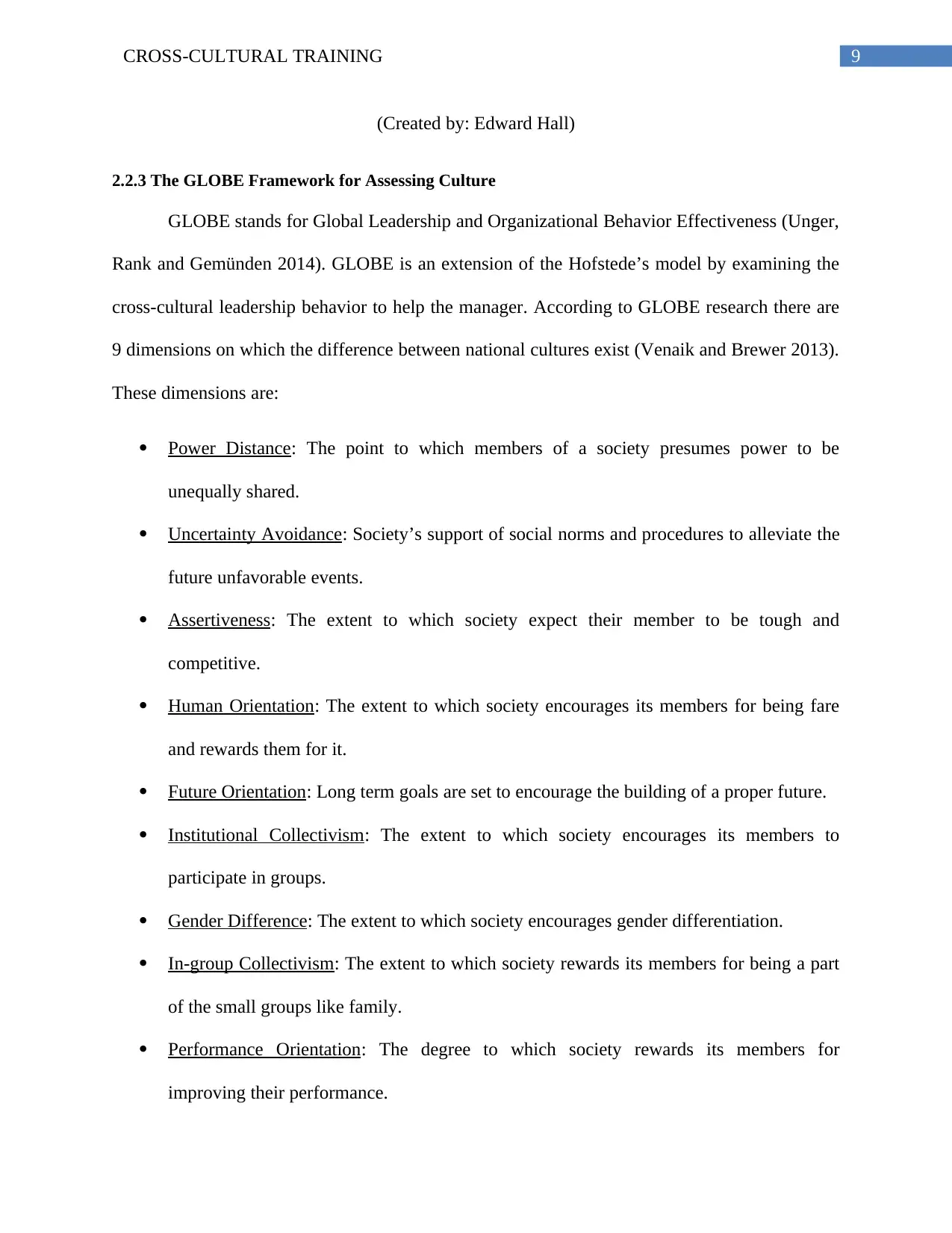
9CROSS-CULTURAL TRAINING
(Created by: Edward Hall)
2.2.3 The GLOBE Framework for Assessing Culture
GLOBE stands for Global Leadership and Organizational Behavior Effectiveness (Unger,
Rank and Gemünden 2014). GLOBE is an extension of the Hofstede’s model by examining the
cross-cultural leadership behavior to help the manager. According to GLOBE research there are
9 dimensions on which the difference between national cultures exist (Venaik and Brewer 2013).
These dimensions are:
Power Distance: The point to which members of a society presumes power to be
unequally shared.
Uncertainty Avoidance: Society’s support of social norms and procedures to alleviate the
future unfavorable events.
Assertiveness: The extent to which society expect their member to be tough and
competitive.
Human Orientation: The extent to which society encourages its members for being fare
and rewards them for it.
Future Orientation: Long term goals are set to encourage the building of a proper future.
Institutional Collectivism: The extent to which society encourages its members to
participate in groups.
Gender Difference: The extent to which society encourages gender differentiation.
In-group Collectivism: The extent to which society rewards its members for being a part
of the small groups like family.
Performance Orientation: The degree to which society rewards its members for
improving their performance.
(Created by: Edward Hall)
2.2.3 The GLOBE Framework for Assessing Culture
GLOBE stands for Global Leadership and Organizational Behavior Effectiveness (Unger,
Rank and Gemünden 2014). GLOBE is an extension of the Hofstede’s model by examining the
cross-cultural leadership behavior to help the manager. According to GLOBE research there are
9 dimensions on which the difference between national cultures exist (Venaik and Brewer 2013).
These dimensions are:
Power Distance: The point to which members of a society presumes power to be
unequally shared.
Uncertainty Avoidance: Society’s support of social norms and procedures to alleviate the
future unfavorable events.
Assertiveness: The extent to which society expect their member to be tough and
competitive.
Human Orientation: The extent to which society encourages its members for being fare
and rewards them for it.
Future Orientation: Long term goals are set to encourage the building of a proper future.
Institutional Collectivism: The extent to which society encourages its members to
participate in groups.
Gender Difference: The extent to which society encourages gender differentiation.
In-group Collectivism: The extent to which society rewards its members for being a part
of the small groups like family.
Performance Orientation: The degree to which society rewards its members for
improving their performance.
Paraphrase This Document
Need a fresh take? Get an instant paraphrase of this document with our AI Paraphraser
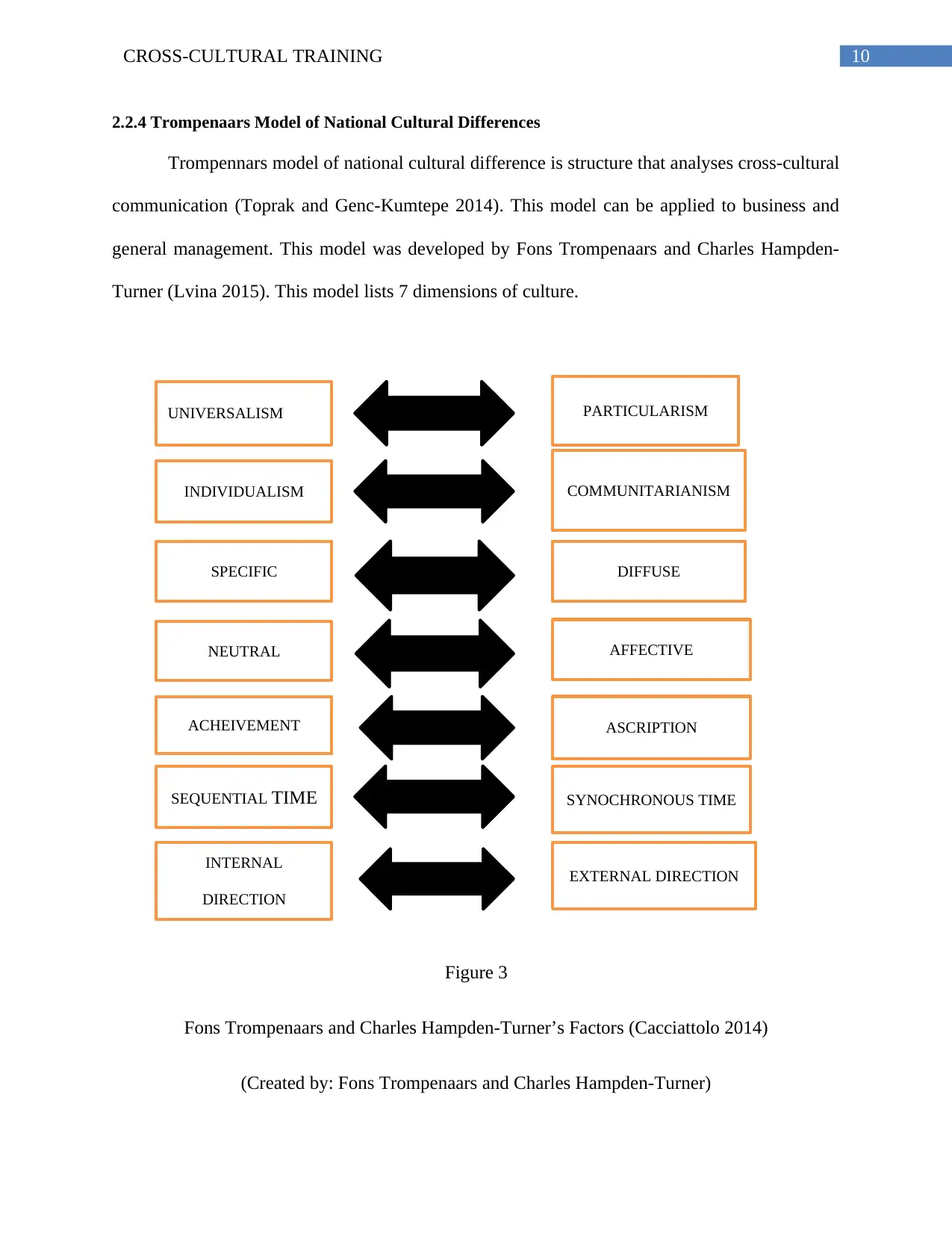
10CROSS-CULTURAL TRAINING
2.2.4 Trompenaars Model of National Cultural Differences
Trompennars model of national cultural difference is structure that analyses cross-cultural
communication (Toprak and Genc-Kumtepe 2014). This model can be applied to business and
general management. This model was developed by Fons Trompenaars and Charles Hampden-
Turner (Lvina 2015). This model lists 7 dimensions of culture.
Figure 3
Fons Trompenaars and Charles Hampden-Turner’s Factors (Cacciattolo 2014)
(Created by: Fons Trompenaars and Charles Hampden-Turner)
UNIVERSALISM PARTICULARISM
INDIVIDUALISM COMMUNITARIANISM
SPECIFIC DIFFUSE
NEUTRAL AFFECTIVE
ACHEIVEMENT ASCRIPTION
SEQUENTIAL TIME SYNOCHRONOUS TIME
INTERNAL
DIRECTION
EXTERNAL DIRECTION
2.2.4 Trompenaars Model of National Cultural Differences
Trompennars model of national cultural difference is structure that analyses cross-cultural
communication (Toprak and Genc-Kumtepe 2014). This model can be applied to business and
general management. This model was developed by Fons Trompenaars and Charles Hampden-
Turner (Lvina 2015). This model lists 7 dimensions of culture.
Figure 3
Fons Trompenaars and Charles Hampden-Turner’s Factors (Cacciattolo 2014)
(Created by: Fons Trompenaars and Charles Hampden-Turner)
UNIVERSALISM PARTICULARISM
INDIVIDUALISM COMMUNITARIANISM
SPECIFIC DIFFUSE
NEUTRAL AFFECTIVE
ACHEIVEMENT ASCRIPTION
SEQUENTIAL TIME SYNOCHRONOUS TIME
INTERNAL
DIRECTION
EXTERNAL DIRECTION
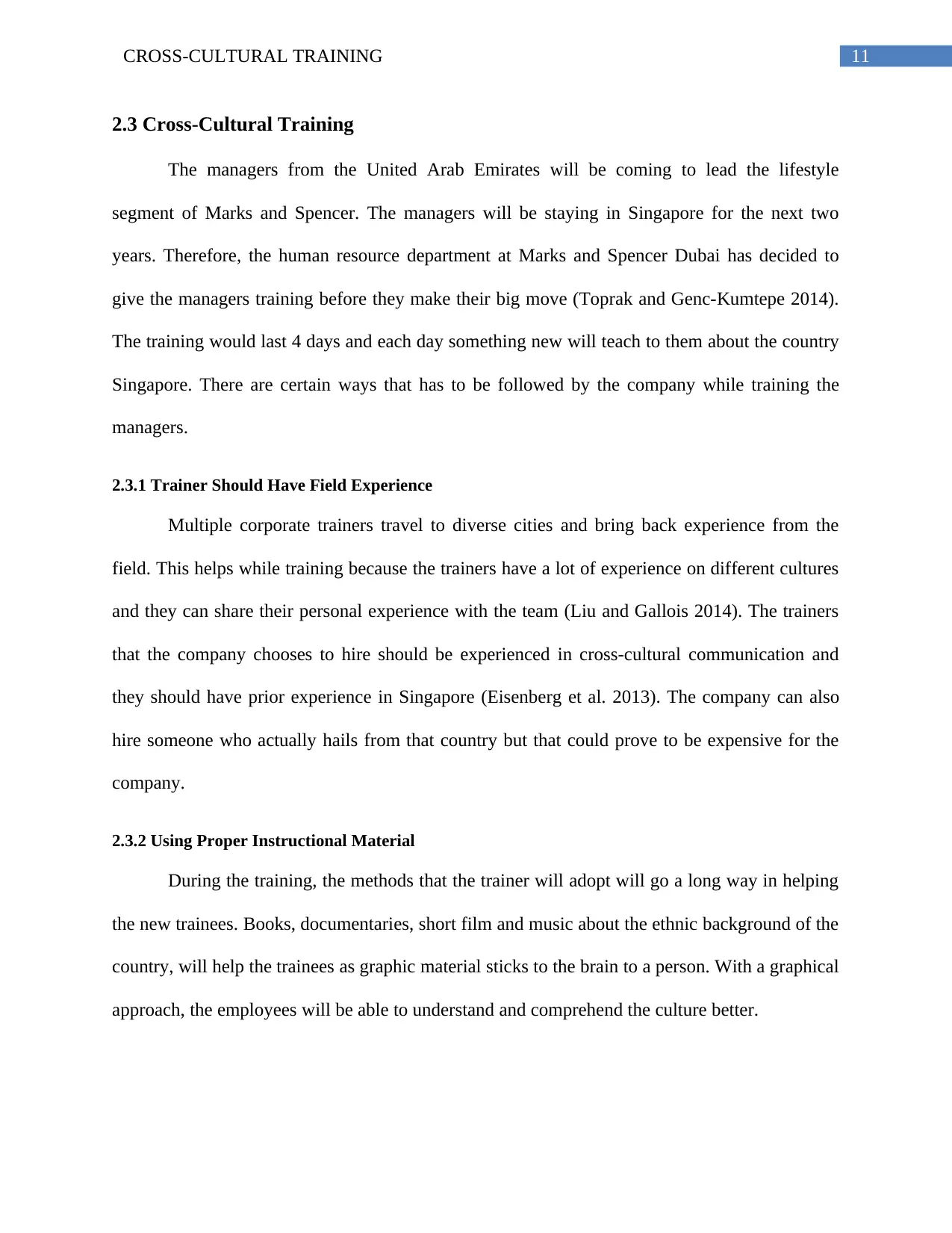
11CROSS-CULTURAL TRAINING
2.3 Cross-Cultural Training
The managers from the United Arab Emirates will be coming to lead the lifestyle
segment of Marks and Spencer. The managers will be staying in Singapore for the next two
years. Therefore, the human resource department at Marks and Spencer Dubai has decided to
give the managers training before they make their big move (Toprak and Genc-Kumtepe 2014).
The training would last 4 days and each day something new will teach to them about the country
Singapore. There are certain ways that has to be followed by the company while training the
managers.
2.3.1 Trainer Should Have Field Experience
Multiple corporate trainers travel to diverse cities and bring back experience from the
field. This helps while training because the trainers have a lot of experience on different cultures
and they can share their personal experience with the team (Liu and Gallois 2014). The trainers
that the company chooses to hire should be experienced in cross-cultural communication and
they should have prior experience in Singapore (Eisenberg et al. 2013). The company can also
hire someone who actually hails from that country but that could prove to be expensive for the
company.
2.3.2 Using Proper Instructional Material
During the training, the methods that the trainer will adopt will go a long way in helping
the new trainees. Books, documentaries, short film and music about the ethnic background of the
country, will help the trainees as graphic material sticks to the brain to a person. With a graphical
approach, the employees will be able to understand and comprehend the culture better.
2.3 Cross-Cultural Training
The managers from the United Arab Emirates will be coming to lead the lifestyle
segment of Marks and Spencer. The managers will be staying in Singapore for the next two
years. Therefore, the human resource department at Marks and Spencer Dubai has decided to
give the managers training before they make their big move (Toprak and Genc-Kumtepe 2014).
The training would last 4 days and each day something new will teach to them about the country
Singapore. There are certain ways that has to be followed by the company while training the
managers.
2.3.1 Trainer Should Have Field Experience
Multiple corporate trainers travel to diverse cities and bring back experience from the
field. This helps while training because the trainers have a lot of experience on different cultures
and they can share their personal experience with the team (Liu and Gallois 2014). The trainers
that the company chooses to hire should be experienced in cross-cultural communication and
they should have prior experience in Singapore (Eisenberg et al. 2013). The company can also
hire someone who actually hails from that country but that could prove to be expensive for the
company.
2.3.2 Using Proper Instructional Material
During the training, the methods that the trainer will adopt will go a long way in helping
the new trainees. Books, documentaries, short film and music about the ethnic background of the
country, will help the trainees as graphic material sticks to the brain to a person. With a graphical
approach, the employees will be able to understand and comprehend the culture better.
⊘ This is a preview!⊘
Do you want full access?
Subscribe today to unlock all pages.

Trusted by 1+ million students worldwide
1 out of 19
Related Documents
Your All-in-One AI-Powered Toolkit for Academic Success.
+13062052269
info@desklib.com
Available 24*7 on WhatsApp / Email
![[object Object]](/_next/static/media/star-bottom.7253800d.svg)
Unlock your academic potential
Copyright © 2020–2025 A2Z Services. All Rights Reserved. Developed and managed by ZUCOL.




